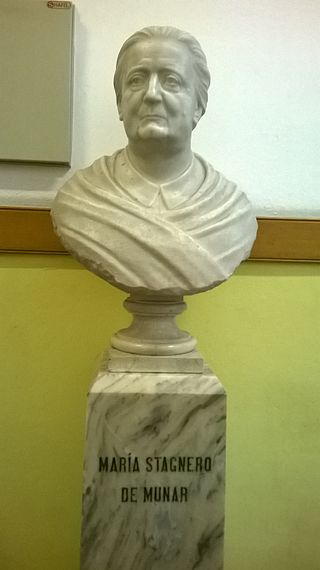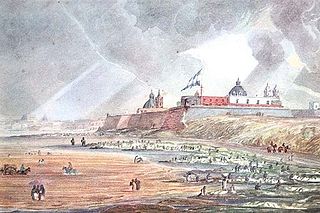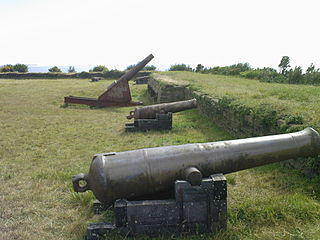
Colonia del Sacramento is a city in southwestern Uruguay, by the Río de la Plata, facing Buenos Aires, Argentina. It is one of the oldest towns in Uruguay and the capital of the Colonia Department. It has a population of around 27,000.

Castillo San Cristóbal is a fortress in the historic district of Old San Juan, Puerto Rico, known as the largest fortification built by the Spanish in the New World. Dating back to defense expansions following attacks by the English in 1598 and the Dutch in 1625, it was first built in 1634 as the Garita del Diablo and an artillery platform. Over the next 150 years, especially in the reign of King Charles III of Spain, it continued to be developed into a bastion fort to reach its largest size in 1790. Rising 150 ft from the Atlantic shoreline, the three-level edifice stands on a hill at the northern coastline of San Juan Islet, guarding the land entry to Old San Juan. San Cristóbal, alongside El Morro, La Fortaleza, and other forts part of the Walls of Old San Juan, protected strategically and militarily important Puerto Rico, or La Llave de las Indias , from invasion by competing world powers during the Age of Sail. It was designated a World Heritage Site by UNESCO in 1983.

Fort San Pedro is a military defense structure in Cebu, Philippines, built by the Spanish under the command of Miguel López de Legazpi, first governor of the Captaincy General of the Philippines. It is located in the area now called Plaza Independencia, in the pier area of the city. The original fort was made of wood and built after the arrival of Legazpi and his expedition. In the early 17th century a stone fort was built to repel Muslim raiders. Today's structure dates from 1738 and is the oldest triangular bastion fort in the country. It served as the nucleus of the first Spanish settlement in the Philippines. During the Philippine Revolution at the end of the 19th century, it was attacked and taken by Filipino revolutionaries, who used it as a stronghold.
Banda Oriental, or more fully Banda Oriental del Río Uruguay, was the name of the South American territories east of the Uruguay River and north of Río de la Plata that comprise the modern nation of Uruguay, the modern state of Rio Grande do Sul, Brazil, and part of the modern state of Santa Catarina, Brazil. It was the easternmost territory of the Viceroyalty of the Río de la Plata.

Chuy is a city in the extreme east of Uruguay, in the Rocha Department, 340 kilometres (211 mi) northeast of Montevideo. It lies on the border with Brazil, separated from its Brazilian sister town of Chuí only by a shared avenue that serves as the border, and by the Arroyo Chuy (stream) to the east. Chuy's population was 9,675 in 2011.

Ciudad Colonial is the historic central neighborhood of the Dominican Republic's capital Santo Domingo. It is the oldest continuously inhabited European-established settlement in the Americas. The area has been declared a World Heritage Site by UNESCO. It is also known as Zona Colonial or more colloquially as "La Zona".

Fortín Solano is an eighteenth-century colonial fortification overlooking Puerto Cabello, Venezuela. With the Castillo San Felipe, an earlier fort built at sea level, it formed part of a complex of fortifications designed to protect Puerto Cabello and its important harbour from naval attacks. It was constructed c. 1766 by order of Don José Solano y Bote on behalf of the King of Spain. It has been described as the last military construction built in Venezuela during the colonial era.

Dieciocho de Julio or 18 de Julio is a small town in the Rocha Department of southeastern Uruguay.

Route 9 is a national route of Uruguay. In 1975, it was assigned the name Coronel Leonardo Olivera, a national hero of Uruguay. It connects Dr. Francisco Soca with Chuy in the northeast.

The Fortaleza de Santa Teresa, or Fortaleza Santa Tereza is a military fortification located 36 km (22 mi) south of Chuy and 305 km (190 mi) northeast of Montevideo on Route 9, in the Rocha Department of eastern Uruguay. It lies about 800 m (2,600 ft) from the coast at Playa la Moza, almost halfway between Angostura and La Coronilla , north of Punta del Diablo and roughly 4 km (2.5 mi) northeast of the northeast bank of the Laguna Negra. It lies within the Santa Teresa National Park. It was erected from October 1762 by the Portuguese, having abandoned the attempt at building a fort in Maldonado and leaving the Fuerte San Miguel.
La Esmeralda is a beach town and seaside locality in Uruguay, Rocha Department.

Santa María de la Cabeza castle is a colonial castle built in the seventeenth century by the Spanish monarchy in the center of the city of Cumaná, Venezuela. It was built as a replacement for the San Antonio de la Eminencia castle. Its construction was ordered by Sancho Fernando de Angulo y Sandoval, governor of the Province of Cumaná. The building was designed using the trace italienne style popular during the seventeenth century, with a proportional geometric floor design. Bastions were used as the main defensive elements. The castle housed a garrison of 250 soldiers, and was the seat of government for the Province of Cumaná.
The Fort of San Diego, formerly also known as the Fort of San Carlos is a star fort in Acapulco, Guerrero, Mexico. It was built by the Spanish Empire, and it was one of the most important Spanish fortifications along the Pacific coast. The fort was first built in the 17th century, but was completely rebuilt in the 18th century. Today, it is an important landmark in Acapulco, and it is open to the public as the Acapulco Historic Museum.

María Stagnero de Munar (1856–1922) was a liberal Uruguayan teacher and feminist. She was a pioneering player in the reform of the Uruguayan school system in the 1880s, establishing the country's first women's teacher training college, Instituto Normal de Señoritas. In 1916, together with her former students, she formed the National Women's Council of Uruguay.

The Fort of Buenos Aires was a fortress destined to defend Buenos Aires and to be the seat of the Spanish colonial authorities in the city. Its construction began in 1595 and after several refurbishments it was finished only at the beginning of the 18th century, being demolished in 1882. It received the name of Real Fortaleza de Don Juan Baltasar de Austria, and in the 17th century it was called Castillo de San Miguel Arcángel del Buen Ayre.

Casa Fuerte de Adeje is a fortified building complex in Adeje, Tenerife, Spain. A strong house was constructed around 1556 to protect a sugar mill, and the site was subsequently significantly expanded. The building complex was renovated in the 1700s before a fire left it in ruins in 1902, a state in which it remains today, leading to its inclusion on the Spanish Redlist of endangered heritage in 2019. Since then some restoration work has taken place and part of the monument has been opened to the public for daily visits.

Agüi Fort, also written as Agui or Ahui, and otherwise known as San Miguel de Agüi Castle), is a fortification located on the Lacuy peninsula, Chile.

The Walls of Old San Juan is a defensive city wall that surrounds the western end of the San Juan Islet, site of the historic district of San Juan, Puerto Rico. This defensive wall system was built between the 16th and 18th centuries to protect the city and the Bay of San Juan, a highly strategic point in the Caribbean. These walls, along with the defensive fortresses in Old San Juan, form part of the UNESCO World Heritage Site-designated San Juan National Historic Site as they are characteristic examples of the historic methods of construction used in military architecture which adapted European designs and techniques to the special conditions of the Caribbean port cities.






















